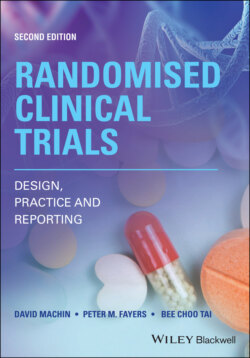Читать книгу Randomised Clinical Trials - David Machin - Страница 73
3.1 Introduction
ОглавлениеDay (2007) defines a protocol as:
A written document describing all the important details of how a study will be conducted. It will generally include details of the products being used, a rationale for the study, what procedures will be carried out on subjects in the study, how many subjects will be studied, the design of the study and how the data will be analysed.
In our context, ‘study’ is replaced by ‘trial’ and commonly ‘products’ will be replaced by ‘treatments’ or ‘interventions’. In particular, a clinical trial protocol is a document that will include sections addressing those design features we have highlighted in Chapter 2, as they relate to the specific trial in question.
As we have pointed out, the questions posed in a clinical trial must be important and so it is vital that the research team identify all the scientific, clinical and practical elements, together with the resources and skills necessary in order to achieve clear answers. This is no small task even when embarking on a clinical trial of moderate size and complexity. A fundamental part of this process, and one that must be undertaken to obtain local and, if appropriate, regulatory approval, is the development of the associated trial protocol. This document must be clear yet concise and contain all the elements necessary for all the members of the investigating teams to carry out their respective tasks. Thus, for any clinical trial, although the main features of the trial from design to analysis will be discussed in detail at the planning stage, the trial itself cannot be conducted unless the finalised plan is thoroughly documented. In broad terms, the range of features to be addressed in the trial protocol is indicated in Figure 3.1 although there may be additional requirements depending on the specifics of the actual trial to be undertaken, and the headings under which particular details fall will also vary with circumstance. For example, patient safety issues may be of paramount concern in one trial in which case this may warrant a dedicated section in the protocol. In others, this may not be the case so such issues may require only brief mention.
Figure 3.1 Major components of a clinical trial protocol
It is very difficult for any one person to think of every detail of all the elements that are needed for a particular protocol and so it is important to involve as broad a team as one can (certainly to include members from a range of disciplines) in the development process.
Further, although this may be mandatory within many situations, a review of the document by two or more experienced but independent peers together with an independent statistician (and other experts as may be relevant) is also advisable. Such a group should also review the data forms, whether paper, electronic or in a web‐based format, to ensure they are clear and that they encapsulate the key features, do not overburden the clinical teams or trial subjects with unnecessary detail yet enable the trial endpoint(s) to be unambiguously recorded for each subject.
Finally, the protocol should be dated, suitably bound in book form, and any subsequent amendments carefully documented. In the following sections, we address the individual sections of a protocol as detailed in Figure 3.1 and, wherever possible, give illustrative examples of how some of the sections have been phrased in activated protocols.
We cannot emphasise too strongly, that the protocol must be a high‐quality document, in both scientific and clinical terms, and needs to be written in clear language with careful highlighting of important issues. The protocol serves many purposes; for example, it gives an overview of the trial process from beginning to end, details the specific interventions, and how these are to be allocated. Importantly it guides the clinician through when and how assessments are to be made, and where necessary provides a step‐by‐step guide to administering the precise interventions stipulated.
Many of the issues introduced here will also be discussed in greater detail in later chapters.
